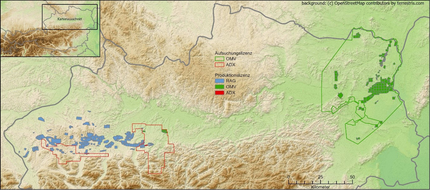Hydrocarbons in Austria
The energy raw materials crude oil and natural gas are found in Austria in economically relevant quantities in the rocks of the Vienna Basin and the Molasse zone. The production areas are in Lower Austria, Upper Austria and Salzburg.
Production volumes of Austria
Currently, three companies are authorised to produce in Austria (OMV, RAG Austria, ADX). Together they produce approximately 500,000 tonnes of crude oil and 600 million m³ of gas annually (as of 2022). The trend in production has been declining for years..
This corresponds to 7 % of annual demand for oil and 5.8 % for gas (as of 2021). The remaining quantities come from imports.
An overview of the production figures and drilling activities of the past year is provided by the “Energierohstoff Referat”, which takes place annually in May as a series of lectures. The presentations and statistics can be found in the archive .
Hydrocarbon reservoir
Crude oil and natural gas form as a result of several processes. The prerequisite is the existence of a source rock rich in organic matter (animal and plant microorganisms). The overlaying of other rocks, the resulting pressure and the associated temperature can initially lead to the formation of kerogen, the initial product of natural gas and crude oil. The hydrocarbons formed in this way migrate along interfaces (faults, fractures) in the rock into porous or fractured rocks (reservoir rocks) until they can no longer move through very well-sealed layers. They therefore accumulate (trap). The reservoirs are thus rock bodies where gas, oil and water are enriched in pores or fissures, comparable to a water-saturated sponge (there are no “gas bubbles” or “oil lakes” underground).
In Austria, the reservoir rocks are mainly sandstones and limestones in the Alpine foothills and Vienna Basin (Weinviertel). In the latter, there is also the Matzen field, which is still one of the largest oil fields on land in Central Europe.
Worldwide, there are also deposits in basalts (e.g. in India) or directly in the source rock (shale gas, USA).
From where to drill into the depths?
Exploration work often begins with the use of geophysical measurements (e.g. gravimetry or seismic). In recent decades, the acquisition of an area with 3D seismic has become a standard method. Acoustic signals are sent into the subsurface, which are reflected and registered at the surface. The data can be interpreted and statements about the geological conditions can be made through changes in the rock properties or also through filled pore spaces (with water, gas or oil). This procedure can be compared to ultrasound diagnoses in medicine.
After the interpretation, regions with increased potential can be identified underground, and at the surface, locations are sought from which these can best be reached at depth with a borehole (borehole planning, prognosis of the rocks, prognosis about the size of the deposit). In Austria, drilling is mostly done on deposits of 1,000–3,000 m depth. However, there are both shallower and deeper deposits that are known through drilling.
Not every drill finds the expected quantities or a rock with the right properties. Therefore, the probability of discovery is estimated beforehand (often wrongly called risk).
The quantities of natural gas and crude oil currently known to exist safely underground in Austria amount to 6.2 billion m³ and 4.7 million tonnes and would be exhausted in 10.2 and 8.8 years, respectively, if production remained constant (as of 2022).
This figure is constantly changing due to new perceptions in the search (high quality 3D seismic), new discoveries, further development of drilling technology (e.g. horizontal drilling) and more efficient production.
Re-use of reservoirs and existing infrastructure
Reservoirs, from which production is no longer possible, can be used to store other gases. In Austria, mainly natural gas is stored. In the Molasse zone as well as in the Vienna Basin, OMV and RAG Austria operate pore storage facilities with a total volume of 8 billion m³ of gas.
In Upper Austria, there is a project where green hydrogen is stored underground. The injection of carbon dioxide into underground storage facilities is currently prohibited in Austria..
Another application for no longer used oil and gas infrastructure (boreholes) for geothermal energy production is recently the content of a Central European research project (EU Interreg) with five partner states and the participation of Geosphere Austria.
Links
Underground pore storage facilities in Austria
» How storage facilities work
» The gas storage facilities of OMV Gas Storage in Austria
Transgeo
» TRANSGEO at a glance
» TRANSGEO


